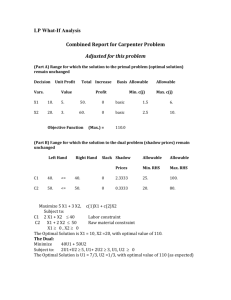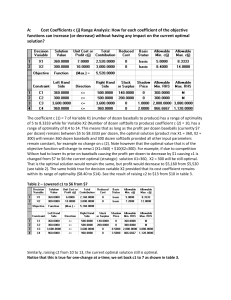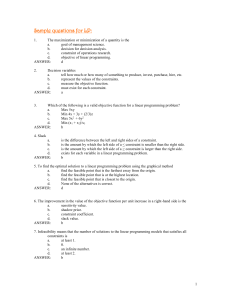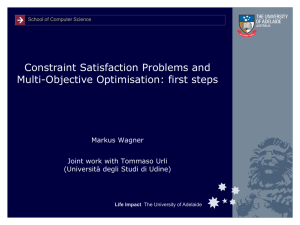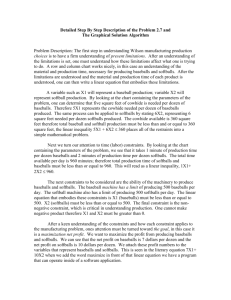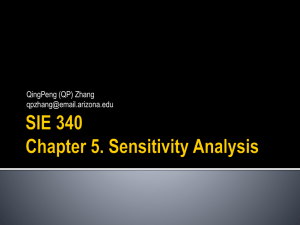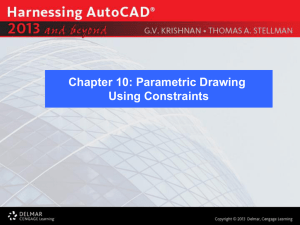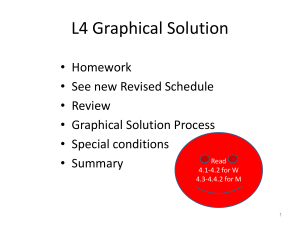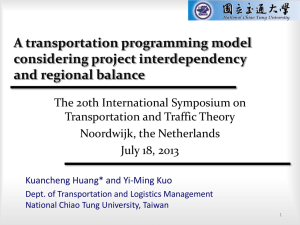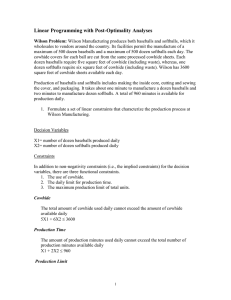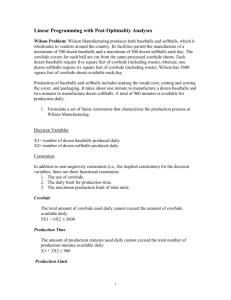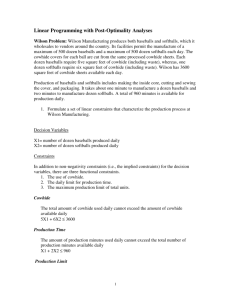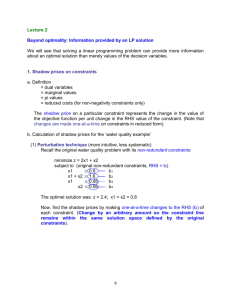Decision Variable: A factor over which the decision maker has
advertisement
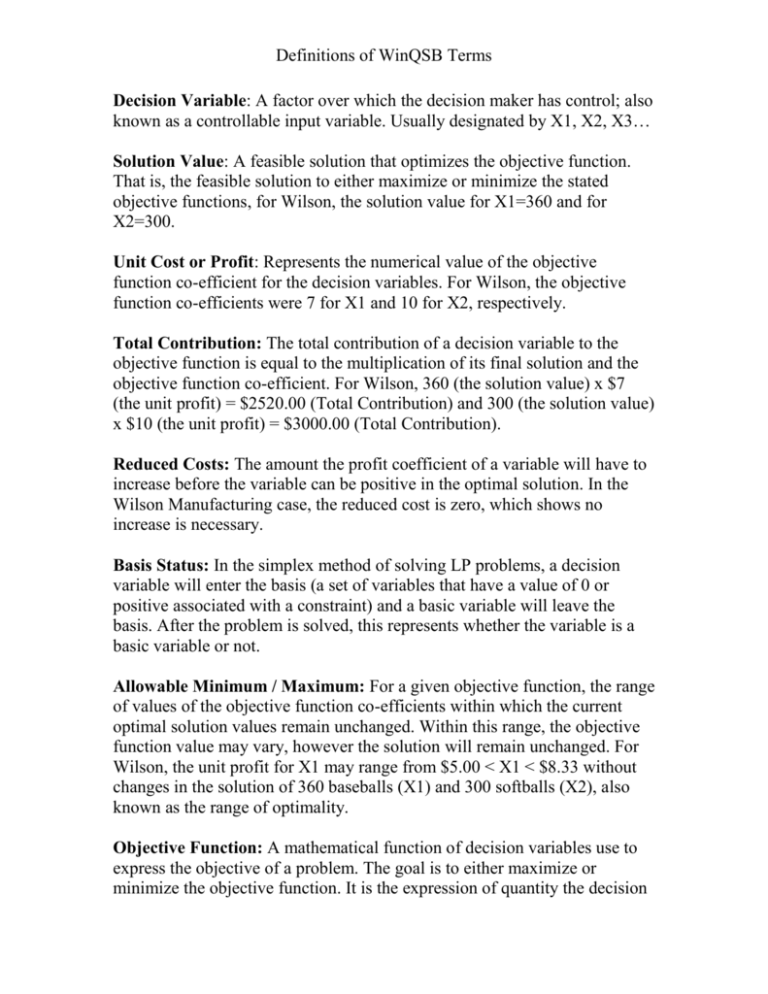
Definitions of WinQSB Terms Decision Variable: A factor over which the decision maker has control; also known as a controllable input variable. Usually designated by X1, X2, X3… Solution Value: A feasible solution that optimizes the objective function. That is, the feasible solution to either maximize or minimize the stated objective functions, for Wilson, the solution value for X1=360 and for X2=300. Unit Cost or Profit: Represents the numerical value of the objective function co-efficient for the decision variables. For Wilson, the objective function co-efficients were 7 for X1 and 10 for X2, respectively. Total Contribution: The total contribution of a decision variable to the objective function is equal to the multiplication of its final solution and the objective function co-efficient. For Wilson, 360 (the solution value) x $7 (the unit profit) = $2520.00 (Total Contribution) and 300 (the solution value) x $10 (the unit profit) = $3000.00 (Total Contribution). Reduced Costs: The amount the profit coefficient of a variable will have to increase before the variable can be positive in the optimal solution. In the Wilson Manufacturing case, the reduced cost is zero, which shows no increase is necessary. Basis Status: In the simplex method of solving LP problems, a decision variable will enter the basis (a set of variables that have a value of 0 or positive associated with a constraint) and a basic variable will leave the basis. After the problem is solved, this represents whether the variable is a basic variable or not. Allowable Minimum / Maximum: For a given objective function, the range of values of the objective function co-efficients within which the current optimal solution values remain unchanged. Within this range, the objective function value may vary, however the solution will remain unchanged. For Wilson, the unit profit for X1 may range from $5.00 < X1 < $8.33 without changes in the solution of 360 baseballs (X1) and 300 softballs (X2), also known as the range of optimality. Objective Function: A mathematical function of decision variables use to express the objective of a problem. The goal is to either maximize or minimize the objective function. It is the expression of quantity the decision Definitions of WinQSB Terms maker wishes to optimize. The objective function (max) is obtained by adding the total contributions of the decision variables. For Wilson, $2,520.00 + $3,000.00 = $5,520.00 Constraint: A restrictive condition that may affect the optimal value for an objective function. Left Hand Side: After the problem is solved, the left hand side value of a constraint is equal to the sum of the decision variable value times it coefficient in the constraint. For example, constraint (C1) for Wilson Manufacturing was 5X1 + 6X2 < 3600. After the problem was solved, 5(360) + 6(300) = 3600; 3600=3600. Direction: Indicates the relationship that exists between the RHS and the LHS of the linear problem. Right Hand Side: The right hand side of a constraint usually represents a constant value that represents the maximum (<, =) or minimum (>) requirement. Slack: The amount of a resource that is left over when the value of the left hand side of the constraint is subtracted from the constant on the right hand side of the constraint. Associated with the “<” constraints. For Wilson, there is “0” slack. Surplus: The amount by which some minimum restriction is exceeded at a given point when the constant on the right hand side is subtracted for the value of the left hand side. Associated with “>” constraints. For Wilson, there is “0” surplus. Shadow Price: It is the (rate of) change to the optimal value of the objective function resulting from a one unit increase in the right hand side of a constraint. The shadow price is also the solution values for the dual. For example, if Wilson Manufacturing suddenly had 3601 feet of cowhide available, the optimal value would increase by $1 (the shadow price) to $5,521.00. Similarly, if Wilson suddenly had 1 additional minute of production time, the objective function values would increase by $2 ($5,522.00). Allowable Minimum / Maximum RHS: The set of right hand side values of a resource over which the shadow prices do not change. It is also known Definitions of WinQSB Terms as the range of feasibility because over this range of values, the solution to the current set of binding constraint equations is a feasible solution. Note: the values of the variables in the optimal solution and the objective function values change; it is the shadow prices that do not change. For example, Wilson Manufacturing may use 2881 to 3879 feet of cowhide to produce its baseballs and softballs and the shadow price will remain $1 for a one-unit increase. As you can see from the table, there are 2 decision variables and the optimal value of this problem is $7 (360) +$10 (300) = $5520 which is stated as Objective function under the column of total contribution. Allowable min and Allowable max columns give us the range of the optimality for the variables, which are baseballs and softballs in this case. The optimal solution will remain unchanged as long as the profit per dozen baseballs lies between $5.00 and $8.33 and as the profit per dozen softballs lies between $8.40 and $14.00. The slack/surplus variable values for the final solution are found in the `SLACK OR SURPLUS' column. The related shadow prices are found to the right of this. The slack variable is the variable added to the left-hand side of a less than or equal to (<=) constraint to convert the constraint into an equality. It can be interpreted as the unused resource or right-hand side. The surplus variable is the variable subtracted from the left-hand side of a greater than or equal to (>=) constraint to convert the constraint into an equality. It can be interpreted as the amount over the requirement or right-hand side. In this case we can see from the table that both of the values are slack values which means that there are 140 dozen unused baseballs and 200 dozen unused softballs. Definitions of WinQSB Terms The shadow price of a constraint is the marginal change of the objective function when the right-hand side value of that constraint increases by one unit, values for which the RHS value can change while maintaining the validity of shadow prices. For the Constraint 1, which is material constraint in this case, the shadow price is $1.00. It basically means that if the righthand site value of material constraint increases by one unit, objective function value changes by $1.00. For the Constraint 2, which is production time constraint in this case, the shadow price is $2.00. It basically means that if the right-hand site value of production time constraint increases by one unit, objective function value changes by $2.00. The shadow price is 0 for constraint 3 (production of baseballs) and constraint 4 (production of softballs). The range of feasibility is determined by looking at the Allowable Min. and Allowable Max range of the constraints. For the material constraint, the range of feasibility is 2,880 to 3,880. They can produce 280 more cowhide sheets. The range of feasibility of the time constraint is 866, 66 to 1,120. They can use 160 min, which is 2 hours and 40 min more for production. For the production limit constraints the range of feasibility are 360 to infinite. The Dual Problem Construction In Dual format, if the primal is max, the dual should be minimization, therefore, as we can see from the table its minimization. The right hand side should be the cost coefficient for dual and also we see that the signs change to the opposite direction. Definitions of WinQSB Terms Minimize 3600 U1 + 960 U2 + 500 U3 + 500 U4 Subject To 5 U1 + 1 U2 + 1 U3 >= 7 6 U1 + 2 U2 + 1 U4 >= 10 Becomes a row for the primal!!! All variables are non-negative.
